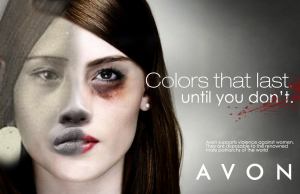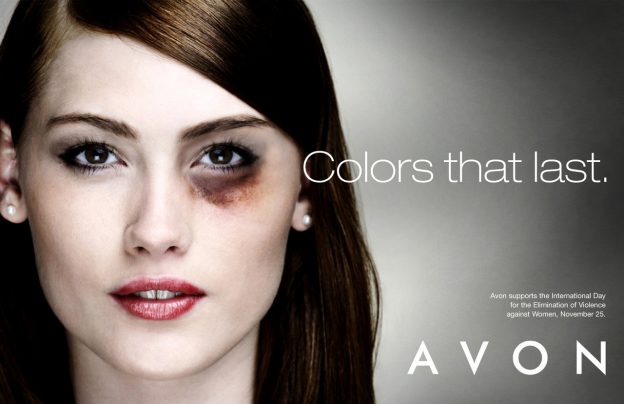This ad by AVON advertises how their makeup provides great coverage with “Colors that last”, and are proud that it can even cover up the bruises and scars sustained from domestic abuse. This is a repulsive message because women suffering from physical or mental abuse do not need makeup, they need access to proper social support, law enforcement, and medical care to ensure their safety and well being. This ad endorses the idea of a male dominated patriarchal society where abusing women is allowed, and that women are expected to simply cover it up and move on. Even though there is small caption that says “AVON supports the International Day for the Elimination of Violence against Women”, this does not divert the consumers attention away from the beaten up woman in the ad. For a passerby that did not notice this miniscule font, the impression they are left with is that AVON’s makeup can cover up damages sustained from abuse on women.
AVON may support the elimination of violence against women by donating money, but by spreading this damaging message through their advertisement inadvertently poisons the consumers mindset. The message they’re sending is that violence of any kind against women is okay, and that it is not of great concern as it can simply be fixed with makeup.
Another problem with this ad, is that the model is an affluent white female that is well groomed and wearing pearl earrings. This ad is discriminating as it does not take into account the diversity of women from different races, ethnicities, and cultural, economic, or social backgrounds. They only care about the westernized stereotypical white female standard of beauty. In addition, there is a problem with how the ad only shows abuse on a white woman to garner more sympathy and attention, instead of portraying an abused ethnic woman for example.

The jammed version of this ad aims to show how domestic abuse is a by-product stemming from societies internalized belief that it is the norm for women to be oppressed under the rule of men. It also aims to expose societies underlying xenophobia and racial discrimination.
I tried to reflect some cultural diversity, and to emphasize that although violence against all women are a problem, black and native women may be at an even higher risk. From a report by the National Intimate Partner and Sexual Violence Survey in 2010, it was shown that 4 out of 10 native women…“have been victim to rape, physical violence, and/or stalking…”and that “[b]lack women are almost three times as likely to experience death as a result of DV/IPV [Domestic and Intimate Partner Violence] than white women” (Domestic Shelters, 2015 & Jones, 2014). It highlights how society would be less inclined to care or take action if the abuse was inflicted on non-white women, so we must overcome the barriers of racial discrimination, xenophobia, and stereotyping to tackle the issue of violence against all women of every ethnicity collectively.
I chose to change the wording of the ad to “Colors that last, until you don’t” to indicate that the woman in the ad will not last as long as the colors from AVON’s makeup, as she will not be able to endure the abuse. The effective way to address the problem of psychological, sexual, or physical abuse is to seek help, and not to cover it up and pretend it never happened.
I also replaced AVON’s message about supporting the elimination of violence against women with “Avon supports violence against women. They are disposable to the renowned male patriarchs of the world”. This satirical comment exposes the underlying message behind the ad, which is how the belief that women are subordinate to men is so ingrained in society that we barely evenly consciously realize it.
The jammed version of this ad hopes to highlight the need to rid societies false conception that women can be treated poorly and inferior to men. It also aims to spread the idea that we should embrace women of all ethnicities in order to work together and make the world a better place for women.
Citation:
Domestic Shelters. (2015, January 7). Demographics and Domestic Violence. Retrieved June 20, 2017, from https://www.domesticshelters.org/domestic-violence-statistics/demographics-and-domestic-violence
Jones, F. (2014, September 10). Why Black Women Struggle More With Domestic Violence. Retrieved June 20, 2017, from http://time.com/3313343/ray-rice-black-women-domestic-violence/

great post